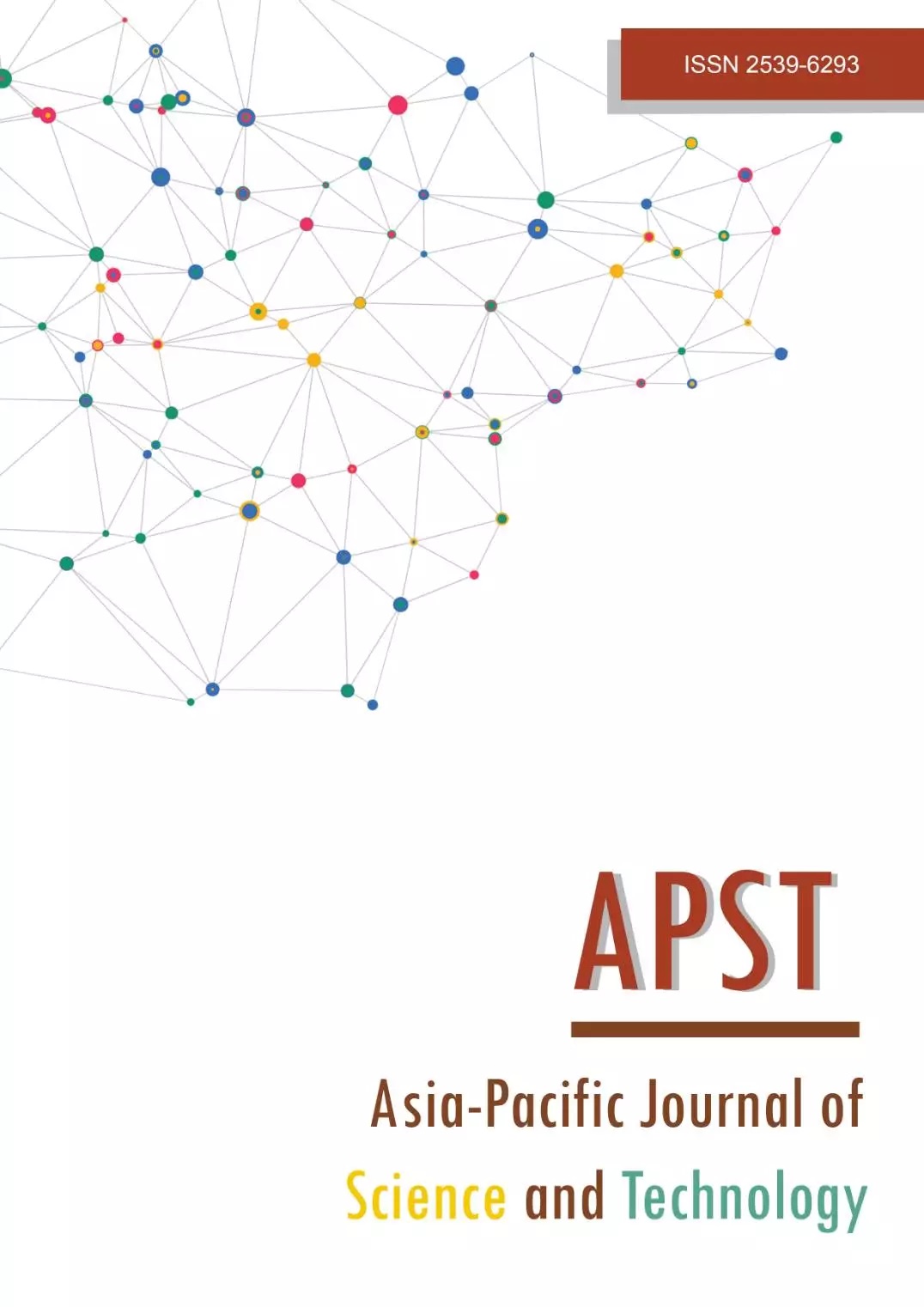Development of gold nanoparticles-based lateral flow sandwich assay for colorimetric and electrochemical detection of bacterial infection biomarker
Main Article Content
Abstract
In this study, two distinct technologies were used for quantitative and qualitative analysis of bacterial infection (BI) specific procalcitonin (PCT) biomarker. lateral flow assay (LFA) strips polyclonal antibody-gold nanoparticles ((pAb-AuNP)/ monoclonal antibody (mAb)/PCT) with the same PCT concentration are used as novel analytical performance on both platforms, and their results are investigated based on the existence of the test line bands. The authors present modified LFA strips (pAb-AuNP/mAb/PCT) for electrochemical studies using electrochemical impedance spectroscopy (EIS). A red band appeared on the test line, implying excellent outcomes. The limit of detection (LOD) for qualitative PCT detection using this LFA has been observed to be 1 ng/mL. The results of LFA- based test lines are validated further using quantitative colorimetric techniques. It demonstrates that the concentration used in qualitative LFA yields positive results and demonstrates a good linear correlation between visually detected ranges of 2 to 60 ng/mL. On the other hand, the quantitative electrochemical method, has a much higher sensitivity for the detection of PCT, with a linear range of 1 to 60 ng/mL, and 1 ng/mL LOD is observed. Furthermore, an LFA-based strip electrode was used in quantitative electrochemical measurements without any electrochemically active surface modifications, ensuring a simple and fast procedure. The quantitative platforms for PCT detection presented not only provide simple, rapid, and impacted methods, but they often can enhance sensing technology in other areas of health diagnostic research.
Article Details

This work is licensed under a Creative Commons Attribution-NonCommercial-NoDerivatives 4.0 International License.
References
GuptaY, Ghrera AS. Recent advances in gold nanoparticle-based lateral flow immunoassay for the detection of bacterial infection, Archi. microbiol. 2021;203(3):3767-3784.
Ventola CL. The antibiotic resistance crisis: part 1: causes and threats. PT. 2015;40(4):277-283.
Chen D, Zhang Y, Xu Y, Shen T, Cheng G, Huang B, et al. Comparison of chemiluminescence immunoassay, enzyme-linked immunosorbent assay and passive agglutination for diagnosis of Mycoplasma pneumoniae infection. Ther Clin Risk Manag. 2018;14:1091-1097.
Cinquanta L, Fontana DE, Bizzaro N. Chemiluminescent immunoassay technology: what does it change in autoantibody detection? Auto Immun Highlights. 2017;8(1):9-9.
Shao XY, Wang CR, Xie CM, Wang XG, Liang RL, Xu WW. Rapid and sensitive lateral flow immunoassay method for procalcitonin (PCT) based on time-resolved immunochromatography. Sensors (Basel). 2017;17(3):480.
Vijayan AL, Vanimaya, Ravindran S, Saikant R, Lakshmi S, Kartik R, et al. Procalcitonin: a promising diagnostic marker for sepsis and antibiotic therapy. J. Intensive Care. 2017;5(1):51.
7. Schuetz P, Albrich W, Mueller B. Procalcitonin for diagnosis of infection and guide to antibiotic decisions: past, present and future. BMC Medicine. 2011;9(1):10726.
Hohn A, Schroeder S, Gehrt A, Bernhardt K, Bein B, Wegscheider K, et al. Procalcitonin-guided algorithm to reduce length of antibiotic therapy in patients with severe sepsis and septic shock. BMC Infect Dis. 2013;13(1):158.
Samsudin I, Vasikaran SD. Clinical utility and measurement of procalcitonin. Clin Biochem Rev. 2017;38(2):59-68.
Sharma S, Rodríguez ZJ, Estrela P, Kennedy R. Point-of-care diagnostics in low resource settings: present status and future role of microfluidics. Biosensors. 2015;5(3):577-601.
Sajid M, Kawde AN, Daud M. Designs, formats and applications of lateral flow assay: a literature review. J Saudi Chem Soc. 2015;19(6):689-705.
Koczula KM, Gallotta A. Lateral flow assays. Essays Biochem. 2016;60(1):111-120.
Khlebtsov BN, Tumskiy RS, Burov AM, Pylaev TE, Khlebtsov NG. Quantifying the numbers of gold nanoparticles in the test zone of lateral flow immunoassay strips. ACS Appl Nano Mater. 2019;2(8):5020-502844.
Zhan N, Zhou Y, Mei L, HanY, Zhang, H. Dual detection of procalcitonin and c-reactive protein with an up-converting nanoparticle based lateral flow assay. Anal Sci. 2019;35(3):257-263.
Serebrennikova KV, Samsonova JV, Osipov AP. A semi-quantitative rapid multi-range gradient lateral flow immunoassay for procalcitonin. Microchim Acta. 2019;186(7):423.
Serebrennikova K, Samsonova J, Osipov A. Hierarchical nanogold labels to improve the sensitivity of lateral flow immunoassay. Nanomicro Lett. 2018;10(2):24-24.
Serebrennikova KV, Samsonova JV, Osipov AP. Enhancement of the sensitivity of a lateral flow immunoassay by using the biotin-streptavidin system. Mosc Univ Chem Bull. 2018;73(3):131-134.
Kim JH, Suh YJ, Park D, Yim H, Kim H, Kim HJ, et al. Technological advances in electrochemical biosensors for the detection of disease biomarkers. Biomed. Eng. Lett. 2021;11(4):309-334.
Malhotra BD, Ali MA. Nanomaterials in biosensors: fundamentals and applications. In: Malhotra BD, Al MA, editors. Nanomaterials for Biosensors. 1st ed. Amsterdam: Elsevier Inc; 2018. p. 1-74.
Zhang X, Guo Q, Cui D. Recent advances in nanotechnology applied to biosensors. Sensors (Basel). 2009;9(2):1033-10553.
Koczula KM, Gallotta A. Lateral flow assays. Essays Biochem. 2016;60(1):111-120.
Rivas L, Muñiz EA, Serrano L, Altet L, Francino O, Sánchez A, et al. Triple lines gold nanoparticle-based lateral flow assay for enhanced and simultaneous detection of Leishmania DNA and endogenous control. Nano Res. 2015;8(11):3704-3714.
Turkevich J, Stevenson PC, Hillier J. A study of the nucleation and growth processes in the synthesis of colloidal gold. Discuss Faraday Soc. 1951;11(0):55-75.
Dong J, Carpinone PL, Pyrgiotakis G, Demokritou P, Moudgil BM. Synthesis of precision gold nanoparticles using Turkevich method. Kona. 2020;37:224-32.
Suchomel P, Kvitek L, Prucek R, Panacek A, Halder A, Vajda S, et al. Simple size-controlled synthesis of Au nanoparticles and their size-dependent catalytic activity. Sci Rep. 2018;8(1):4589.
Al K, Amarah K, Alhasnawi IA, Majeed ADB, Jafar A. A Simple method for synthesis, purification and concentration stabilized goldnanoparticles. Int J Eng Res Appl. 2013;3(6):21-30.
Tanak AS, Jagannath B, Tamrakar Y, Muthukumar S, Prasad S. Non-faradaic electrochemical impedimetric profiling of procalcitonin and c-reactive protein as a dual marker biosensor for early sepsis
detection. Anal Chim Acta. 2019;(3):100029.
Li X, Qin Z, Fu H, Li T, Peng R, Li Z, et al. Enhancing the performance of paper-based electrochemical impedance spectroscopy nanobiosensors: an experimental approach. Biosens Bioelectrons. 2021;177:112672.


